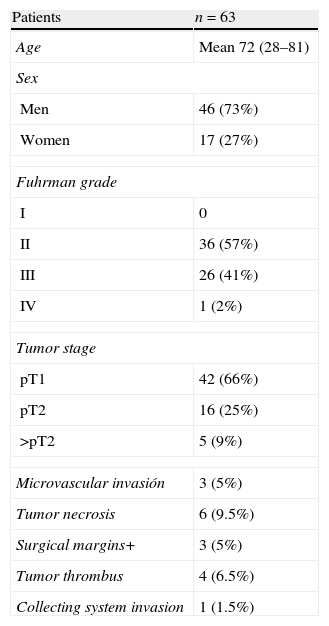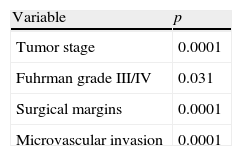The identification of new subtypes of renal cell carcinoma (RCC) has made it necessary to re-evaluate the current clinical and pathological predictive factors (stage, Fuhrman nuclear grade, necrosis, lymphovascular invasion [LVI] and sarcomatoid component) in these new subtypes. The chromophobe renal cell carcinoma (CRCC) is considered a less aggressive subtype of RCC. The purpose of this article is to evaluate the usefulness of current clinicopathologic predictors of RCC in our series of CRCC.
Material and methodsWe retrospectively reviewed the clinicopathologic features of 63 patients with CRCC treated with radical nephrectomy. The parameters analyzed were tumor extension with the TNM, grade according to Fuhrman classification, LVI, tumor necrosis, tumor thrombus, surgical margin status, and involvement of the collecting system. The results (disease recurrence) were evaluated by Cox regression model with univariate and multivariate analysis.
ResultsWith a median follow up of 60.2 months (0.37–160.2), 8 (11%) patients had recurrence, with median time to recurrence of 31.7 months (5.37–124.33). In the univariate analysis, TNM extension (p=0.0001), Fuhrman grade III or IV (p=0.031), LVI (p=0.0001) and the presence of positive surgical margins (p=0.0001) were statistically significant variables for recurrence. In the multivariate analysis, only tumor stage was confirmed as an independent predictor of recurrence, pT1 versus pT2 (p=0.02; OR 0.27; 95% CI 0.03–0.258) and pT2 versus higher stage (p=0.037; OR 0.173; 95% CI 0.033–0.896).
ConclusionsThe tumor stage predicts aggressiveness in the CCRC. The classification of Fuhrman nuclear grade is not useful for this histological subtype.
La identificación de nuevos subtipos de carcinoma de células renales (CCR) ha hecho que sea necesaria una reevaluación de los factores predictivos clínico-patológicos vigentes (estadio, grado de Fuhrman, necrosis, invasión linfo-vascular [ILV] intrarrenal y componente sarcomatoide) en estos nuevos subtipos. El carcinoma renal de células cromófobas (CRCC) se considera un subtipo de CCR menos agresivo. Este artículo pretende evaluar la utilidad de los actuales factores predictivos clínico patológicos del CCR en nuestra serie de CRCC.
Material y métodosSe realizó una revisión retrospectiva de las características clínicopatológicas de 63 pacientes que fueron tratados mediante nefrectomía radical por CRCC. Los parámetros analizados fueron la extensión TNM, el grado de Fuhrman, ILV, necrosis, trombo tumoral, márgenes quirúrgicos y compromiso del sistema colector. Los resultados (recurrencia de enfermedad) se valoraron mediante regresión de Cox con análisis uni y multivariante.
ResultadosCon una mediana de seguimiento de 60,2 meses (0,37-160,2), 8 (11%) pacientes presentaron recurrencia, con un tiempo medio hasta la recurrencia de 31,7 meses (5,37-124,33). En el análisis univariante la extensión TNM (p = 0,0001), grado Fuhrman III o IV (p = 0,031), la ILV (p = 0,0001) y la presencia de márgenes quirúrgicos positivos (p = 0,0001) fueron variables estadísticamente significativas para recurrencia. En el análisis multivariante solo el estadio se confirmó como factor predictivo independiente de recurrencia, pT1 versus pT2 (p = 0,02; OR 0,27; IC 95%: 0,03-0,258) y en pT2 versus estadio superior (p = 0,037; OR: 0,173; IC 95%: 0,033-0,896).
ConclusionesEl estadio tumoral predice agresividad en el CCRC. La clasificación del grado nuclear de Fuhrman no es útil para este subtipo histológico.










